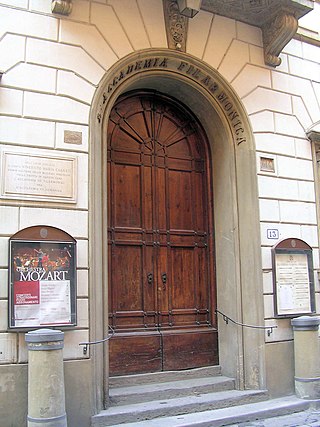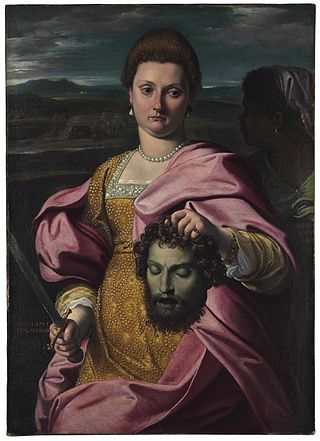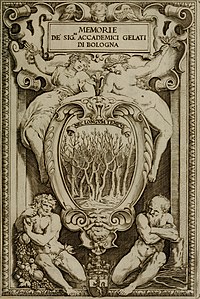History
The Accademia dei Gelati was founded in Bologna in 1588 by a group of young gentlemen associated with the university led by Melchiorre Zoppio. Its members gathered at Zoppio's house, in a marvelous room with a theater and a rich library. Zoppio was one of the Academy's keenest members, adopting the name Caliginoso within it and leaving it a room for its meetings in his will. [2]
The name of the Academy refers to the academicians belief that their literary conversations would "enflame" their "frozen" intellects.
The subjects of the first meetings were love poetry and the Neoplatonic philosophy of love. Later, the Academy developed a great interest in philosophy. Following Plato's philosophical gatherings, the academicians discussed the most subtle philosophical issues after a friendly dinner. They called these meetings "Cene de' saggi" (dinners of wise men).
Influenced by the example of Bologna’s senior poet, Cesare Rinaldi, the Gelati quickly published two verse anthologies, Ricreazioni amorose (1590) and Rime (1597), which were early landmarks in the transition from Petrarchism to Conceptismo. Their verse is characterized by extended metaphors which went well beyond the orthodox Petrarchist canon.
As has recently been recognized, the poets of the Gelati, and Rinaldi especially, played an important role in transforming the late lyric style of Torquato Tasso into the highly sensuous and conspicuously ingenious poetry for which Marino is famous, and it was in Bologna that Marino first encountered many of the imaginative techniques that he so brilliantly developed in his own poetry.
Subsequently, led by Claudio Achillini and Ridolfo Campeggi, the Gelati championed the poetry of Giambattista Marino. Their own later production included much religious verse and tended to the moderate Baroque style typified by another academician, Girolamo Preti.
They published biographies of their leading members as Memorie imprese, e ritratti de' Signori Accademici Gelati (1670), and were also involved as theorists in the development of Bolognese Baroque painting. The Academy had close links with many of the most important Bolognese artists of the day. During Agostino Carracci's funeral in Bologna, it was Lucio Faberio, a member of the Academy, who delivered the funeral oration. [5] The laws of the Accademia dei Gelati were published for the first time in 1670.

Geminiano Montanari was an Italian astronomer, lens-maker, and proponent of the experimental approach to science. He was a member of various learned academies, notably the Accademia dei Gelati. Montanari's famous students include Domenico Guglielmini, Francesco Bianchini, Gianantonio Davia and Luigi Ferdinando Marsili.

The Gallerie dell'Accademia is a museum gallery of pre-19th-century art in Venice, northern Italy. It is housed in the Scuola della Carità on the south bank of the Grand Canal, within the sestiere of Dorsoduro. It was originally the gallery of the Accademia di Belle Arti di Venezia, the art academy of Venice, from which it became independent in 1879, and for which the Ponte dell'Accademia and the Accademia boat landing station for the vaporetto water bus are named. The two institutions remained in the same building until 2004, when the art school moved to the Ospedale degli Incurabili.

The Accademia di San Luca is an Italian academy of artists in Rome. The establishment of the Accademia de i Pittori e Scultori di Roma was approved by papal brief in 1577, and in 1593 Federico Zuccari became its first principe or director; the statutes were ratified in 1607. Other founders included Girolamo Muziano and Pietro Olivieri. The Academy was named for Luke the Evangelist, the patron saint of painters.

The Accademia Filarmonica di Bologna is a music education institution in Bologna, Italy.

The Accademia di Belle Arti di Bologna is a public tertiary academy of fine art in Bologna, in Emilia-Romagna in northern Italy. It has a campus in Cesena.

Carlo Cesare Malvasia (1616–1693) was an Italian scholar and art historian from Bologna, best known for his biographies of Baroque artists titled Felsina pittrice, published in 1678. Together with his contemporary Giovanni Pietro Bellori, Malvasia is considered "among the best informed and most intelligent historians and critics of art who ever lived."

Conte Carlo Antonio Manzini was an Italian astronomer and mathematician.. Manzini was one of the best scholars of astronomy and optics of his time.

Antonio Randa was an Italian painter of the classicist period, active in Ferrara, Modena, Rovigo, Florence, Comacchio and his native Bologna.

Girolamo Graziani was an Italian poet and diplomat.
The Accademia degli Incamminati was one of the first art academies in Italy, founded in 1582 in Bologna.
Melchiorre or Melchior Zoppio was an Italian doctor and scholar.
Girolamo Zoppio was a 16th-century Bolognese writer. A street in Bologna and a lecture hall in the University of Bologna both bear his name.

Cesare Rinaldi an Italian early Baroque poet.

Girolamo Giacobbi was an Italian choirmaster, conductor, and composer.

Portrait of a Woman as Judith is an oil on canvas painting by Agostino Carracci, from c. 1590-1595, now in a private collection. It is signed A. CAR. BON. at bottom left.

Girolamo Preti was an Italian Baroque poet. He is considered one of the most accomplished of early 17th-century poets.

The Accademia degli Oziosi was the most famous Neapolitan literary academies of the Renaissance.
Count Ridolfo Campeggi was an Italian nobleman, Marinist poet, librettist, and playwright.
Andrea Barbazza was an Italian Marinist poet and literary critic.
This page is based on this
Wikipedia article Text is available under the
CC BY-SA 4.0 license; additional terms may apply.
Images, videos and audio are available under their respective licenses.














